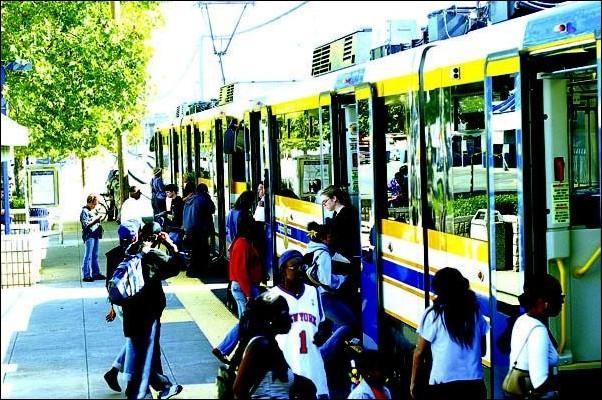Project would bring light rail to campus
Image: Project would bring light rail to campus:Commuters boarding the light rail on 65th Street on Monday could have additional transportation options to get to Sacramento State in two years if funding is secured for a project that would include a light-rail extension and a track around campus. :
October 12, 2005
Commuter relief may be speeding its way to campus in less than two years.
A proposed public transportation project would entail a 65th Street light-rail extension that would loop around Sacramento State’s campus and stop at stations every five minutes, said Matt Altier, executive director of University Enterprises, Inc. Sac State’s non-profit business entity.
University Enterprises hopes the project will entice riders as an easy, convenient and comfortable alternative to driving.
“We’re trying to create a greener environment and encourage people to ride public transportation,” Altier said.
The system is called Bus Rapid Transit even though it won’t look anything like a traditional bus.
Instead, the design will resemble a “European-style bullet train” and will glide on a separate set of rubber tracks to shuttle commuters to and from campus, Altier said.
To move ahead with the project, University Enterprises must first obtain a grant from the Sacramento Area Council of Governments for funding.
Nancy Kays, senior planner for the council, said the type of grant that University Enterprises will be applying for is highly competitive and gives $12 million to projects chosen in Yolo, Sacramento, Yuba and Sutter counties.
“The purpose of the grant is to provide incentives for smart growth,” Kays said.
Kays said that projects are reviewed based on their quality of design, possibilities for refill development and the potential for people to live, shop, work and go to appointments in the same area.
“Smart growth means developing inside of your cities instead of sprawling out,” Kays said.
The deadline for the grant is Jan. 12. Projects that receive the money will be announced in March, Kays said.
Altier said that the light rail extension would help create more redevelopment and contribute to the growing feeling of a college community around 65th Street.
Positive feedback has come from both Sacramento Regional Transit and the California Department of Transportation, Altier said.
“We’re in support of it,” said Jan Mendoza, a spokeswoman for Cal Trans.
A recent campuswide survey gave University Enterprises the thumbs up from faculty, staff and students for the light rail project.
Out of 2,500 responses, 58 percent said that they would be interested in taking the light rail extension – that would be a big jump from the one percent that currently utilizes light rail, Altier said.
“Even if only 10 percent of students took the light rail, that would be 3,000-5,000 less cars in the parking lots,” Altier said.
If the grant is approved, engineering, layouts and cost estimates would take nine-to-10 months before groundbreaking can begin, Altier said. The project is slated to be finished in two years if everything goes as planned.
“We’re going after the plan aggressively; hopefully we can get going on it soon,” Altier said.
The project is a feature of the larger Destination 2010 goals set forth by University President Alexander Gonzalez.
After the light rail station is built, a connecting rail line from Ramona Avenue to the university will be constructed, Altier said. The light rail will connect faculty housing, which will be constructed south of Folsom Blvd., to Sac State.
Altier said that the University of Oregon is the first campus to use a Bus Rapid Transit system, and Sac State’s system would be modeled after theirs.
Oregon’s shuttle system, the Breeze, was built in 1996 and brings University of Oregon students to the Eugene, Ore., light rail Station.
The Breeze increased light rail commuting at Oregon by approximately 1,000 riders a day, said Rand Stamm, head of Transportation and Parking Services at Oregon.
Jessica Weidling can be reached at [email protected]







































































































































